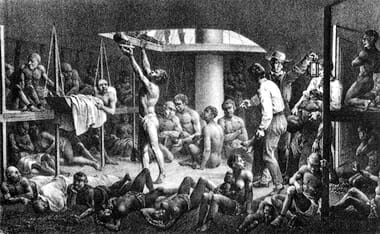(ORIGINALLY POSTED ON JAN 18, 2015)
- “…virtually every significant racist in American political history was a Democrat.”
Bruce Bartlett, Wrong on Race: The Democratic Party’s Buried Past (New York, NY: Palgrave MacMillan, 2008), ix;
- “…not every Democrat was a KKK’er, but every KKK’er was a Democrat.”
Ann Coulter, Mugged: Racial Demagoguery from the Seventies to Obama (New York, NY: Sentinel [Penguin], 2012), 19.
Thomas Sowell’S Full Chapter on the “Real History of Slavery”
ISOLATED and ART ADDED OF THE ABOVE:
History of Slavery, Dixie Crats,
Southern Strategy, Party Switch, etc.
- Obama’s Nazi-like church of twenty-years
- Radical Groups Support the Democrats (Even the KKK)
- Did the Party’s Switch?
- The Democrat Race Lie – by Bob Parks
Slavery
- Excerpts on Slavery (D’Souza, Williams, Johnson, and Sowell)
- Some Historical Perspective on Slavery (Medved, Roberts)
- Percentages Of Slaves Brought To America (Davis, Sowell)
- The Bible & Slavery (Me: PDF)
-
- Does the Bible Command Slavery? (Detective J. Warner Wallace)
- Obama Gets Slavery via the Bible Wrong (Dennis Prager)
- How Democrats Have Used the Bible Wrong (Alfonzo Rachel)
- Suing the Democrats Over Slavery, Lynching, and Jim Crow
- Democrats Responsible for Slavery, Republican Party for Abolition
- Fallacies of Slavery and Race
- American Slavery: Separating Fact From Myth
- Democrats Support White Supremacy
- Republicans Work to End Slavery
- US Constitution is Anti-Slavery
- Congress Celebrates the End of Slavery
- Neglected Voices of African Americans
- Reconstruction: The Good, the Bad and the Ugly
The Third Force Act, also known as the KKK or the Civil Rights Act of 1871, empowered President Ulysses S. Grant to use the armed forces to combat those who conspired to deny equal protection of the laws and, if necessary, to suspend habeas corpus to enforce the act. Grant signed the legislation on this day in 1871. After the act’s passage, the president for the first time had the power to suppress state disorders on his own initiative and suspend the right of habeas corpus. Grant did not hesitate to use this authority. (POLITICO)
Terrorist Arm of the Democrats
- Blacks AND Whites [Because Republican] Lynched by Democrat KKK
- The Southern Strategy Myth (Ann Coulter)
- Radical Groups Support the Democrats (Even the KKK)
- Democrats founded the KKK, fought the 13th, 14th and 15th Amendments, instituted Jim Crow Laws, fought the 1965 Civil Rights Act
- The Rev. Wayne Perryman On Democratic Racism
- Wayne Perryman Sues the Democrat Party for Reparations
- Great Moments in Democrat Racist History ~ Hugo Black
- Democrats and the KKK
Southern Strategy/Dixiecrats Switch
- Did The Party’s Switch? (Dinesh D’Souza, Ann Coulter)
- Frequently Asked Questions ~ National Black Republican Association (NBRA)
- The So-Called Party Switch (Weapon of A.S.S. Destruction ~ excerpt)
- Larry Elder Is Coerced to [Southern] Strategize About History
- 1957 Republicans vs. 1964 Democrats
- The “Southern Strategy” Debunked ~ Again
- The Civil Rights Legacy Democrats Stole from Republicans, Pt. 1 ~ (part 2 is HERE)
- Did Democrats and Republicans Switch Sides? (Greedy, Fascist, Racist Republicans)
- The Southern Strategy Myth and the Lost Majority: How Republicans Really Won The South
- Urban Legends: The Southern Strategy
- Urban Legends: Dixiecrats and the GOP
- Malcom X: Dixiecrats are Democrats in Disguise
- The Dixiecrat Myth
- The Myth of the Racist Republicans (This is a review of 5-books):
1) The Southern Strategy Revisited: Republican Top-Down Advancement in the South, by Joseph A. Aistrup.
2) The Rise of Southern Republicans, by Earl Black and Merle Black.
3) From George Wallace to Newt Gingrich: Race in the Conservative Counterrevolution, 1963-1994, by Dan T. Carter.
4) A Stone of Hope: Prophetic Religion and the Death of Jim Crow, by David L. Chappell.
5) The Emerging Republican Majority, by Kevin Phillips.
- Southern Strategy
- ANOTHER LIBERAL LIE EXPOSED: The Myth of the Southern Strategy
- Nixon’s Southern Strategy: The Democrat-Lie Keeping Their Control Over the Black Community
- Democrat “Party Switch” Myth Debunked
- Five Decades of Lies Help Dems Create Monolithic Black Vote
- Southern Whites’ Shift to the GOP Predates the ’60s
- Great Moments in Democrat Racist History– the 1964 vote Count
- “We have lost the South for a generation” ~ What Lyndon Johnson said, or would have said if only he had said it
- As the South abandoned its prejudices, it shifted to the GOP
- PICKET: Coulter shreds ‘southern strategy’ myth as GOP successfully runs more blacks in conservative districts
- Racist Democrats vs. Colorblind Republicans
- What Did Lee Atwater Really Say?

